Advances in Shape Memory Alloy-Based Reinforcement in Steel Structures: A Review
Abstract
:1. Introduction
2. Research Significance
3. Material Properties of SMAs
3.1. Shape Memory Effect
- (1)
- As (Austenite Start Temperature): The temperature at which the transformation of martensite to austenite starts.
- (2)
- Af (Austenite Finish Temperature): The temperature of the full transformation of martensite to austenite.
- (3)
- Ms (Martensite Start Temperature): The temperature at which the transformation of austenite to martensite initiates.
- (4)
- Mf (Martensite Finish Temperature): The temperature at which austenite fully transforms to martensite.
3.2. Superelastic Effect and Damping Effect
4. Mechanical Properties of SMAs
4.1. Basic Mechanical Properties
4.2. Cycling Loading
4.2.1. Comparison of Different Elements of SMAs
4.2.2. Effect of Annealing on Mechanical Properties of SMAs
4.2.3. Fatigue Properties
5. SMA-Based Components and Technologies for Reinforced Steel Structures
5.1. Fe-SMA Strip
5.1.1. Reinforcement Mechanism
5.1.2. Mechanical Properties
5.1.3. Connection and Activating Methods
5.2. SMA/CFRP Composite Patch
5.2.1. Reinforcement Mechanism
5.2.2. Bonding Performance between SMA and CFRP
5.2.3. Mechanical Properties
5.3. SMA-Based Damper and Brace
6. Applications of SMA-Based Reinforcement in Steel Structures
6.1. Crack Restoration
6.2. Bearing Capacity Reinforcement
6.3. Seismic Retrofitting
7. Analysis and Discussion
- (1)
- At present, most of the research on SMAs is based on Nitinol-SMAs and has been more perfect, but the research on Fe-SMAs is still in the initial stage. Although Fe-SMAs are not as good as Nitinol-SMAs in terms of performance and the existence form, their relatively low price makes them have the potential to be widely used in practical engineering. Therefore, it is still necessary to take a step further into the basic mechanical behavior of Fe-SMAs and consider the factors affecting the mechanical properties of Fe-SMAs from the perspective of practical applications.
- (2)
- The design and development of SMA-based components are mainly focused on the seismic field, but there are relatively few in the field of structural reinforcement. In fact, SMAs have great potential for applications in the field of structural reinforcement, and their core competencies compared to traditional reinforcement methods include the following: (1) self-adaptability, SMAs possess shape memory properties, allowing them to adapt their shape based on external temperature or strain conditions. This means that SMAs can actively apply restoring forces when the structure is subjected to external loads or deformations, enhancing the structural stability and resistance; (2) lightweight, SMAs are relatively lightweight, so they can reinforce structures without adding excessive additional weight. This is particularly advantageous for situations where reducing loads is important, such as the maintenance and retrofitting of old or unstable structures; (3) minimal construction required, SMA reinforcement typically requires less construction work compared to traditional methods. This can reduce construction time and costs, as well as minimize disruption to the original structure; (4) excellent controllability, the properties of SMAs can be customized through alloy composition and heat treatment to meet specific engineering requirements. This allows for precise design and tuning based on the needs of a particular project; (5) high-temperature performance, SMAs typically exhibit good performance at high temperatures, which is crucial for structures operating in high-temperature environments, such as industrial equipment or buildings in hot regions; (6) self-healing, SMAs have some degree of self-healing capability and can restore their original shape through external stimulation, reducing maintenance and repair costs. Therefore, there is still much room for research on and the development of SMA-based reinforcement components, both in terms of form and function.
- (3)
- Currently, the use of SMAs in steel structure reinforcement is not very common, and current research is still at the conceptualization stage; thus, there is a need to intensify research in this area. In addition to the above-mentioned research and development on material properties, SMA-based components, and technologies, there is a need to develop advanced construction techniques applicable to SMA reinforcement, such as SMA-activation methods and connection methods. On this basis, design methods for SMA-based structural steel reinforcement should be explored, and clear design guidelines and criteria should be established to ensure the correct application of SMAs in different situations.
- (4)
- Although SMA-based reinforcement can be used as a potential alternative to traditional reinforcement methods due to its unique characteristics, an assessment of its cost-effectiveness in practical applications is indispensable. Currently, there are fewer cost-effectiveness analyses of SMA-based reinforcement methods, and they are only considered in terms of static indicators, such as the material cost, construction cost, and labor [39], ignoring the advantages of the material properties of SMAs under long-term service. Therefore, to make an accurate comparison between the cost-effectiveness of SMAs and traditional methods, a comprehensive life-cycle cost analysis should be conducted. In addition to the static indicators mentioned earlier, the following factors should be considered in the analysis: (1) long-term performance and maintenance costs, when properly designed and implemented, SMAs provide long-term benefits by reducing the need for frequent maintenance and repairs. They are able to recover from deformations caused by external factors, resulting in cost savings over the entire life cycle of the structure; (2) energy and environmental impact, although the production of SMAs might have a higher energy cost compared to traditional reinforcement materials, the potential long-term benefits in terms of reduced maintenance and repair could lead to lower energy consumption and a smaller environmental footprint; (3) structural performance and safety, SMAs offer unique advantages in terms of improving the structural performance and safety of steel structures, especially in high-stress environments. Their ability to absorb energy and recover from deformations can contribute to improved resilience and reduced risks of structural failure.
- (5)
- In recent years, a large number of SMA-based anti-flexural braces have been proposed and have demonstrated excellent self-centering, displacement-limiting, and energy-dissipation capabilities. The anti-flexing principle is to avoid pressure on SMA bars, which is effective but wastes the excellent compression properties of SMAs. Therefore, it is necessary to investigate anti-flexural bracing that preserves the compressive properties of SMAs to maximize the mechanical properties of SMAs, such as the LSR proposed by Cao et al. [104].
- (6)
- Research on and the development of SMAs continue to evolve, with a focus on expanding their applications in civil engineering. Several potential future directions and emerging trends could impact the use of SMAs in structural reinforcement: (1) improved material performance, develop novel SMA compositions and refine the manufacturing processes to create more robust and cost-effective materials for civil engineering applications; (2) integration of smart technologies, the integration of SMAs with smart sensing and monitoring technologies is an emerging trend. This integration could enable the early detection of potential structural failures and improve maintenance strategies; (3) advancements in 3D printing techniques, 3D printing technology offers new possibilities for the fabrication of complex SMA-based structural components with intricate geometries. Research efforts are focusing on developing innovative 3D printing techniques that can produce customized SMA elements, leading to more efficient and precise structural reinforcement solutions; (4) nanostructured SMAs, the development of nanostructured SMAs with excellent mechanical properties and higher performance characteristics for better resistance to wear, corrosion, and fatigue.
- (7)
- Temperature has a very significant effect on the fatigue properties of SMAs, and annealing changes the transition temperature of SMAs. There is little information available on whether the change in the transition temperature due to annealing improves the fatigue properties of SMAs at different temperatures. This knowledge gap needs to be bridged in future studies.
8. Conclusions
- (1)
- The study of the mechanical behavior of Fe-SMAs under different environmental conditions needs to be strengthened, and the influence of the loading history on the shape memory effect is not well understood.
- (2)
- The research on SMA-based reinforcement components and techniques needs to be deepened, especially for Fe-SMA-based components.
- (3)
- Previous studies have only focused on the fatigue performance of SMA reinforcement and have not analyzed the improvement of the overall seismic performance of the structure after SMA reinforcement. Due to the characteristics of SMAs, this aspect of research should also be emphasized.
- (4)
- A rational design method is the basis for engineering applications. Scholars have verified the feasibility of applying SMAs to steel structure reinforcement, but no comprehensive SMA-based design method has been proposed for steel structure reinforcement.
- (5)
- Little attention has been paid to the fatigue performance of SMAs, and most studies have not considered the effects of environmental factors. Therefore, the fatigue performance of SMAs under the coupling of various environmental factors should be studied more thoroughly.
- (6)
- Annealing has a very important effect on the mechanical properties of SMAs, and a suitable annealing program can reduce the residual deformation of SMAs by more than 50%. However, most of the current research in this field has been performed from a superelasticity point of view to find the optimal annealing solution for a specific SMA part. The effect of annealing on its law should be studied in depth from several angles, such as the fatigue life of SMAs.
- (7)
- The cost-effectiveness of SMA reinforcement techniques cannot be analyzed only from a static point of view, such as material costs and construction costs. They should also be analyzed in terms of life-cycle costs, taking into account the long-term performance, environmental impact, and structural performance and safety.
Author Contributions
Funding
Data Availability Statement
Acknowledgments
Conflicts of Interest
References
- Kirk, R.S.; Mallett, W.J. Highway Bridge Conditions: Issues for Congress. Library of Congress; Congressional Research Service: Washington, DC, USA, 2014. [Google Scholar]
- Woo, S.K.; Nam, J.W.; Kim, J.H.J.; Han, S.H.; Byun, K.J. Suggestion of flexural capacity evaluation and prediction of prestressed CFRP strengthened design. Eng. Struct. 2008, 30, 3751–3763. [Google Scholar] [CrossRef]
- Kamruzzaman, M.; Jumaat, M.Z.; Sulong, N.H.R.; Islam, A. A Review on Strengthening Steel Beams Using FRP under Fatigue. Sci. World J. 2014. [Google Scholar] [CrossRef] [PubMed]
- Dogar, A.U.R.; Rehman, H.; Tafsirojjaman, T.; Iqbal, N. Experimental investigations on inelastic behaviour and modified Gerber joint for double-span steel trapezoidal sheeting. Structures 2020, 24, 514–525. [Google Scholar] [CrossRef]
- Olofsson, I.; Elfgren, L.; Bell, B.; Paulsson, B.; Niederleithinger, E.; Jensen, J.S.; Feltrin, G.; Taljsten, B.; Cremona, C.; Kiviluoma, R.; et al. Assessment of European railway bridges for future traffic demands and longer lives—EC project “Sustainable Bridges”. Struct. Infrastruct. Eng. 2005, 1, 93–100. [Google Scholar] [CrossRef]
- Wang, W.; Chan, T.-M.; Zhang, Y.; Engineering, C. Special issue on resilience in steel structures. Front. Struct. 2016, 10, 237–238. [Google Scholar] [CrossRef]
- Liu, B.F.; Wang, Q.F.; Hu, S.L.; Zhang, W.; Du, C.Z. On thermomechanical behaviors of the functional graded shape memory alloy composite for jet engine chevron. J. Intell. Mater. Syst. Struct. 2018, 29, 2986–3005. [Google Scholar] [CrossRef]
- Zhou, J.W.; Hou, J.Y.; Shi, Y.T. Shape Memory Alloy Materials and Exercise-induced Bone Injury. In Proceedings of the International Conference on Mechanical Engineering, Civil Engineering and Material Engineering (MECEM 2013), Hefei, China, 27–28 October 2013; pp. 257–262. [Google Scholar]
- Fallon, P.D.; Gerratt, A.P.; Kierstead, B.P.; White, R.D. Shape Memory Alloy and Elastomer Composite MEMS Actuators. In Proceedings of the Nanotechnology Conference and Trade Show (Nanotech 2008), Boston, MA, USA, 1–5 June 2008; pp. 470–473. [Google Scholar]
- Zhou, X.L.; Yuan, Q.J.; Chen, L.; Chen, J.; Deng, T.X.; Hu, Y.Q.; Li, A. Determination of the Design Parameters of SMA Cables for Self-Centering Frame Structures. Buildings 2023, 13, 1019. [Google Scholar] [CrossRef]
- Hong, K.N.; Yeon, Y.M.; Ji, S.W.; Lee, S. Flexural Behavior of RC Beams Using Fe-Based Shape Memory Alloy Rebars as Tensile Reinforcement. Buildings 2022, 12, 190. [Google Scholar] [CrossRef]
- Yang, T.; Liu, S.L.; Xiong, S.Y.; Liu, Y.; Liu, B.; Li, B.B. Simulation Analysis of the Small Wild Goose Pagoda Structure Using a Shape Memory Alloy-Suspension Pendulum Damping System (SMA-SPDS). Buildings 2022, 12, 686. [Google Scholar] [CrossRef]
- Foraboschi, P. Predictive formulation for the ultimate combinations of axial force and bending moment attainable by steel members. Int. J. Steel Struct. 2020, 20, 705–724. [Google Scholar] [CrossRef]
- Foraboschi, P. Lateral load-carrying capacity of steel columns with fixed-roller end supports. J. Build. Eng. 2019, 26, 100879. [Google Scholar] [CrossRef]
- Zareie, S.; Issa, A.S.; Seethaler, R.J.; Zabihollah, A. Recent advances in the applications of shape memory alloys in civil infrastructures: A review. Structures 2020, 27, 1535–1550. [Google Scholar] [CrossRef]
- Fang, C.; Zheng, Y.; Chen, J.B.; Yam, M.C.H.; Wang, W. Superelastic NiTi SMA cables: Thermal-mechanical behavior, hysteretic modelling and seismic application. Eng. Struct. 2019, 183, 533–549. [Google Scholar] [CrossRef]
- Ghafoori, E.; Wang, B.; Andrawes, B. Shape memory alloys for structural engineering: An editorial overview of research and future potentials. Eng. Struct. 2022, 273, 115138. [Google Scholar] [CrossRef]
- Alam, M.S.; Youssef, M.A.; Nehdi, M. Analytical prediction of the seismic behaviour of superelastic shape memory alloy reinforced concrete elements. Eng. Struct. 2008, 30, 3399–3411. [Google Scholar] [CrossRef]
- Fang, C.; Zhou, X.Y.; Osofero, A.I.; Shu, Z.; Corradi, M. Superelastic SMA Belleville washers for seismic resisting applications: Experimental study and modelling strategy. Smart Mater. Struct. 2016, 25, 105013. [Google Scholar] [CrossRef]
- Park, J.; Choi, E.; Park, K.; Kim, H.T. Comparing the cyclic behavior of concrete cylinders confined by shape memory alloy wire or steel jackets. Smart Mater. Struct. 2011, 20, 094008. [Google Scholar] [CrossRef]
- Araki, Y.; Endo, T.; Omori, T.; Sutou, Y.; Koetaka, Y.; Kainuma, R.; Ishida, K. Potential of superelastic Cu-Al-Mn alloy bars for seismic applications. Earthq. Eng. Struct. Dyn. 2011, 40, 107–115. [Google Scholar] [CrossRef]
- Zhang, Y.F.; Hu, X.B.; Zhu, S.Y. Seismic performance of benchmark base-isolated bridges with superelastic Cu-Al-Be restraining damping device. Struct. Control Health Monit. 2009, 16, 668–685. [Google Scholar] [CrossRef]
- Rojob, H.; El-Hacha, R. Self-Prestressing Using Iron-Based Shape Memory Alloy for Flexural Strengthening of Reinforced Concrete Beams. ACI Struct. J. 2017, 114, 523–532. [Google Scholar] [CrossRef]
- El Naggar, A.; Youssef, M.A. Shape memory alloy heat activation: State of the art review. Aims Mater. Sci. 2020, 7, 836–858. [Google Scholar] [CrossRef]
- Zhang, Z.X.; Zhang, J.; Wu, H.L.; Ji, Y.Z.; Kumar, D.D. Iron-Based Shape Memory Alloys in Construction: Research, Applications and Opportunities. Materials 2022, 15, 1723. [Google Scholar] [CrossRef]
- Yang, Z.; Li, J.K.; Zhong, Y.L.; Qi, X.L. Mechanical Properties of SMA/PVA-ECC under Uniaxial Tensile Loading. Buildings 2023, 13, 2116. [Google Scholar] [CrossRef]
- Billah, A.M.; Rahman, J.; Zhang, Q. Shape memory alloys (SMAs) for resilient bridges: A state-of-the-art review. Structures 2022, 37, 514–527. [Google Scholar] [CrossRef]
- Frick, C.P.; Ortega, A.M.; Tyber, J.; Maksound, A.E.M.; Maier, H.J.; Liu, Y.N.; Gall, K. Thermal processing of polycrystalline NiTi shape memory alloys. Mater. Sci. Eng. A-Struct. Mater. Prop. Microstruct. Process. 2005, 405, 34–49. [Google Scholar] [CrossRef]
- Mahtabi, M.J.; Shamsaei, N.; Rutherford, B. Mean strain effects on the fatigue behavior of superelastic Nitinol alloys: An experimental investigation. In Proceedings of the 6th International Conference on Fatigue Design (Fatigue Design), Senlis, France, 18–19 November 2015; pp. 646–654. [Google Scholar]
- Saikrishna, C.N.; Ramaiah, K.V.; Paul, D.; Bhaumik, S.K. Enhancement in fatigue life of NiTi shape memory alloy thermal actuator wire. Acta Mater. 2016, 102, 385–396. [Google Scholar] [CrossRef]
- Miyazaki, S.; Mizukoshi, K.; Ueki, T.; Sakuma, T.; Liu, Y.N. Fatigue life of Ti-50 at.% Ni and Ti-40Ni-10Cu (at.%) shape memory alloy wires. Mater. Sci. Eng. A-Struct. Mater. Prop. Microstruct. Process. 1999, 273, 658–663. [Google Scholar] [CrossRef]
- Koster, M.; Lee, W.; Schwarzenberger, M.; Leinenbach, C. Cyclic deformation and structural fatigue behavior of an FE–Mn–Si shape memory alloy. Mater. Sci. Eng. A 2015, 637, 29–39. [Google Scholar] [CrossRef]
- Li, L.; Zhao, X.X.; Cheng, J.W. Research on Fatigue Performance of Shape-Memory Alloy Bars under Low Cyclic Loading. Buildings 2023, 13, 1553. [Google Scholar] [CrossRef]
- Yang, Z.; Deng, T.Y.; Fu, Q.S. The Effect of Fiber End on the Bonding Mechanical Properties between SMA Fibers and ECC Matrix. Buildings 2023, 13, 2027. [Google Scholar] [CrossRef]
- Lin, C.K.; Wang, Z.Q.; Yang, X.; Zhou, H.J. Experimental Study on Temperature Effects on NiTi Shape Memory Alloys under Fatigue Loading. Materials 2020, 13, 573. [Google Scholar] [CrossRef] [PubMed]
- Gu, X.L.; Chen, Z.Y.; Yu, Q.Q.; Ghafoori, E. Stress recovery behavior of an Fe-Mn-Si shape memory alloy. Eng. Struct. 2021, 243, 112710. [Google Scholar] [CrossRef]
- Cladera, A.; Weber, B.; Leinenbach, C.; Czaderski, C.; Shahverdi, M.; Motavalli, M. Iron-based shape memory alloys for civil engineering structures: An overview. Constr. Build. Mater. 2014, 63, 281–293. [Google Scholar] [CrossRef]
- Yeon, Y.M.; Nam, H.K.; Lee, J.; Sangwon, J. Evaluation of Corrosion Behavior for Fe-based Shape Memory Alloy. J. Korean Soc. Adv. Compos. Struct. 2021, 12, 50–56. [Google Scholar] [CrossRef]
- Hosseini, A.; Michels, J.; Izadi, M.; Ghafoori, E. A comparative study between Fe-SMA and CFRP reinforcements for prestressed strengthening of metallic structures. Constr. Build. Mater. 2019, 226, 976–992. [Google Scholar] [CrossRef]
- Wang, S.Z.; Li, L.Z.; Su, Q.T.; Jiang, X.; Ghafoori, E. Strengthening of steel beams with adhesively bonded memory-steel strips. Thin-Walled Struct. 2023, 189, 110901. [Google Scholar] [CrossRef]
- Li, L.; Wang, S.; Chatzi, E.; Motavalli, M.; Ghafoori, E. Prediction of prestress level in steel structures strengthened by bonded Fe-SMA strips. ce/papers 2023, 6, 364–368. [Google Scholar] [CrossRef]
- Hong, K.; Lee, S.; Han, S.; Yeon, Y. Evaluation of Fe-Based Shape Memory Alloy (Fe-SMA) as Strengthening Material for Reinforced Concrete Structures. Appl. Sci. 2018, 8, 730. [Google Scholar] [CrossRef]
- Ghafoori, E.; Hosseini, E.; Leinenbach, C.; Michels, J.; Motavalli, M. Fatigue behavior of a Fe-Mn-Si shape memory alloy used for prestressed strengthening. Mater. Des. 2017, 133, 349–362. [Google Scholar] [CrossRef]
- Marinopoulou, E.; Katakalos, K. Thermomechanical Fatigue Testing on Fe-Mn-Si Shape Memory Alloys in Prestress Conditions. Materials 2023, 16, 237. [Google Scholar] [CrossRef]
- Hosseini, E.; Ghafoori, E.; Leinenbach, C.; Motavalli, M.; Holdsworth, S.R. Stress recovery and cyclic behaviour of an Fe-Mn-Si shape memory alloy after multiple thermal activation. Smart Mater. Struct. 2018, 27, 025009. [Google Scholar] [CrossRef]
- Izadi, M.; Hosseini, A.; Michels, J.; Motavalli, M.; Ghafoori, E. Thermally activated iron-based shape memory alloy for strengthening metallic girders. Thin-Walled Struct. 2019, 141, 389–401. [Google Scholar] [CrossRef]
- Dong, Z.Z.; Klotz, U.E.; Leinenbach, C.; Bergamini, A.; Czaderski, C.; Motavalli, M. A Novel Fe-Mn-Si Shape Memory Alloy With Improved Shape Recovery Properties by VC Precipitation. Adv. Eng. Mater. 2009, 11, 40–44. [Google Scholar] [CrossRef]
- Leinenbach, C.; Kramer, H.; Bernhard, C.; Eifler, D. Thermo-Mechanical Properties of an Fe-Mn-Si-Cr-Ni-VC Shape Memory Alloy with Low Transformation Temperature. Adv. Eng. Mater. 2012, 14, 62–67. [Google Scholar] [CrossRef]
- Czaderski, C.; Shahverdi, M.; Bronnimann, R.; Leinenbach, C.; Motavalli, M. Feasibility of iron-based shape memory alloy strips for prestressed strengthening of concrete structures. Constr. Build. Mater. 2014, 56, 94–105. [Google Scholar] [CrossRef]
- Lee, W.J.; Weber, B.; Leinenbach, C. Recovery stress formation in a restrained Fe-Mn-Si-based shape memory alloy used for prestressing or mechanical joining. Constr. Build. Mater. 2015, 95, 600–610. [Google Scholar] [CrossRef]
- Shahverdi, M.; Czaderski, C.; Motavalli, M. Iron-based shape memory alloys for prestressed near-surface mounted strengthening of reinforced concrete beams. Constr. Build. Mater. 2016, 112, 28–38. [Google Scholar] [CrossRef]
- Izadi, M.R.; Ghafoori, E.; Shahverdi, M.; Motavalli, M.; Maalek, S. Development-of an iron-based shape memory alloy (Fe-SMA) strengthening system for steel plates. Eng. Struct. 2018, 174, 433–446. [Google Scholar] [CrossRef]
- Michels, J.; Shahverdi, M.; Czaderski, C. Flexural strengthening of structural concrete with iron-based shape memory alloy strips. Struct. Concr. 2018, 19, 876–891. [Google Scholar] [CrossRef]
- Dong, Z.Z.; Sawaguchi, T.; Kajiwara, S.; Kikuchi, T.; Kim, S.H.; Lee, G.C. Microstructure change and shape memory characteristics in welded Fe-28Mn-6Si-5Cr-0.53Nb-0.06C alloy. Mater. Sci. Eng. A-Struct. Mater. Prop. Microstruct. Process. 2006, 438, 800–803. [Google Scholar] [CrossRef]
- Soroushian, P.; Ostowari, K.; Nossoni, A.; Chowdhury, H. Repair and Strengthening of Concrete Structures Through Application of Corrective Posttensioning Forces with Shape Memory Alloys. Transp. Res. Rec. 2001, 1770, 20–26. [Google Scholar] [CrossRef]
- Hong, K.; Lee, S.; Yeon, Y.; Jung, K. Flexural Response of Reinforced Concrete Beams Strengthened with Near-Surface-Mounted Fe-Based Shape-Memory Alloy Strips. Int. J. Concr. Struct. Mater. 2018, 12, 45. [Google Scholar] [CrossRef]
- El-Hacha, R.; Rojob, H. Flexural strengthening of large-scale reinforced concrete beams using near-surface -mounted self-prestressed iron-based shape-memory alloy strips. PCI J. 2018, 63, 55–65. [Google Scholar] [CrossRef]
- Izadi, M.R.; Ghafoori, E.; Motavalli, M.; Maalek, S. Iron-based shape memory alloy for the fatigue strengthening of cracked steel plates: Effects of re-activations and loading frequencies. Eng. Struct. 2018, 176, 953–967. [Google Scholar] [CrossRef]
- Izadi, M.; Motavalli, M.; Ghafoori, E. Iron-based shape memory alloy (Fe-SMA) for fatigue strengthening of cracked steel bridge connections. Constr. Build. Mater. 2019, 227, 116800. [Google Scholar] [CrossRef]
- Qiang, X.; Duan, X.; Jiang, X.; Lu, Q.; Zhou, G.J.E.S. Experimental study on mechanical properties of bolted joints between Fe-SMA and steel plates. Eng. Struct. 2023, 297, 116980. [Google Scholar] [CrossRef]
- Qiang, X.H.; Wu, Y.P.; Wang, Y.H.; Jiang, X. Research Progress and Applications of Fe-Mn-Si-Based Shape Memory Alloys on Reinforcing Steel and Concrete Brdiges. Appl. Sci. 2023, 13, 3404. [Google Scholar] [CrossRef]
- Fritsch, E.; Izadi, M.; Ghafoori, E. Development of nail-anchor strengthening system with iron-based shape memory alloy (Fe-SMA) strips. Constr. Build. Mater. 2019, 229, 117042. [Google Scholar] [CrossRef]
- Wang, W.D.; Li, L.Z.; Hosseini, A.; Ghafoori, E. Novel fatigue strengthening solution for metallic structures using adhesively bonded Fe-SMA strips: A proof of concept study. Int. J. Fatigue 2021, 148, 106237. [Google Scholar] [CrossRef]
- Li, L.Z.; Chatzi, E.; Ghafoori, E. Debonding model for nonlinear Fe-SMA strips bonded with nonlinear adhesives. Eng. Fract. Mech. 2023, 282, 109201. [Google Scholar] [CrossRef]
- Li, L.Z.; Wang, W.D.; Chatzi, E.; Ghafoori, E. Experimental investigation on debonding behavior of Fe-SMA-to-steel joints. Constr. Build. Mater. 2023, 364, 129857. [Google Scholar] [CrossRef]
- Choi, E.; Ostadrahimi, A.; Kim, W.J.; Seo, J. Prestressing effect of embedded Fe-based SMA wire on the flexural behavior of mortar beams. Eng. Struct. 2021, 227, 111472. [Google Scholar] [CrossRef]
- Shahverdi, M.; Czaderski, C.; Annen, P.; Motavalli, M. Strengthening of RC beams by iron-based shape memory alloy bars embedded in a shotcrete layer. Eng. Struct. 2016, 117, 263–273. [Google Scholar] [CrossRef]
- Wang, C.P.; Wen, Y.H.; Peng, H.B.; Xu, D.Q.; Li, N. Factors affecting recovery stress in Fe-Mn-Si-Cr-Ni-C shape memory alloys. Mater. Sci. Eng. A-Struct. Mater. Prop. Microstruct. Process. 2011, 528, 1125–1130. [Google Scholar] [CrossRef]
- Wang, Z.Y.; Wang, Q.Y.; Li, L.H.; Zhang, N. Fatigue behaviour of CFRP strengthened open-hole steel plates. Thin-Walled Struct. 2017, 115, 176–187. [Google Scholar] [CrossRef]
- Aljabar, N.J.; Zhao, X.L.; Al-Mahaidi, R.; Ghafoori, E.; Motavalli, M.; Powers, N. Effect of crack orientation on fatigue behavior of CFRP-strengthened steel plates. Compos. Struct. 2016, 152, 295–305. [Google Scholar] [CrossRef]
- Chen, T.; Gu, X.L.; Qi, M.; Yu, Q.Q. Experimental Study on Fatigue Behavior of Cracked Rectangular Hollow-Section Steel Beams Repaired with Prestressed CFRP Plates. J. Compos. Constr. 2018, 22, 04018034. [Google Scholar] [CrossRef]
- Colombi, P.; Fava, G.; Sonzogni, L. Fatigue crack growth in CFRP-strengthened steel plates. Compos. Part B-Eng. 2015, 72, 87–96. [Google Scholar] [CrossRef]
- Colombi, P.; Fava, G. Experimental study on the fatigue behaviour of cracked steel beams repaired with CFRP plates. Eng. Fract. Mech. 2015, 145, 128–142. [Google Scholar] [CrossRef]
- Xu, Y.; Otsuka, K.; Toyama, N.; Yoshida, H.; Nagai, H.; Oishi, R.; Kikushima, Y.; Yuse, K.; Akimune, Y.; Kishi, T. Fabrication technique of SMA/CFRP smart composites. In Proceedings of the Conference on Transducing Materials and Devices, Brugge, Belgium, 30 October–1 November 2002; pp. 35–46. [Google Scholar]
- Li, L.Z.; Chen, T.; Gu, X.L.; Ghafoori, E. Heat Activated SMA-CFRP Composites for Fatigue Strengthening of Cracked Steel Plates. J. Compos. Constr. 2020, 24, 04020060. [Google Scholar] [CrossRef]
- El-Tahan, M.; Dawood, M.; Song, G. Development of a self-stressing NiTiNb shape memory alloy (SMA)/fiber reinforced polymer (FRP) patch. Smart Mater. Struct. 2015, 24, 065035. [Google Scholar] [CrossRef]
- Xue, Y.J.; Cai, D.C.; Wang, W.W.; Tian, J.; Zhen, J.S.; Li, B.C. Prestress loss and flexural behavior of precracked RC beams strengthened with FRP/SMA composites. Compos. Struct. 2023, 321, 117319. [Google Scholar] [CrossRef]
- Xue, Y.J.; Wang, W.W.; Tan, X.; Hui, Y.X.; Tian, J.; Zhu, Z.F. Mechanical behavior and recoverable properties of CFRP shape memory alloy composite under different prestrains. Constr. Build. Mater. 2022, 333, 127186. [Google Scholar] [CrossRef]
- Abdy, A.I.; Hashemi, M.J.; Al-Mahaidi, R. Fatigue life improvement of steel structures using self-prestressing CFRP/SMA hybrid composite patches. Eng. Struct. 2018, 174, 358–372. [Google Scholar] [CrossRef]
- Jang, B.K.; Xu, Y.; Oishi, R.; Nagai, H.; Yoshida, H.; Akimune, Y.; Otsuka, K.; Kishi, T. Thermomechanical characterization and development of SMA embedded CFRP composites with self-damage control. In Proceedings of the Smart Structures and Materials 2002 Conference, San Diego, CA, USA, 18–21 March 2002; pp. 182–190. [Google Scholar]
- Xue, Y.J.; Wang, W.W.; Wu, Z.H.; Hu, S.W.; Tian, J. Experimental study on flexural behavior of RC beams strengthened with FRP/SMA composites. Eng. Struct. 2023, 289, 116288. [Google Scholar] [CrossRef]
- Xu, Y.; Otsuka, K.; Toyama, N.; Yoshida, H.; Jang, B.K.; Nagai, H.; Oishi, R.; Kishi, T. Fabrication of TiNi/CFRP smart composite using cold drawn TiNi wires. In Proceedings of the Smart Structures and Materials 2002 Conference, San Diego, CA, USA, 18–21 March 2002; pp. 564–574. [Google Scholar]
- Xue, Y.J.; Wang, W.W.; Tian, J.; Wu, Z.H. Experimental study and analysis of RC beams shear strengthened with FRP/SMA composites. Structures 2023, 55, 1936–1948. [Google Scholar] [CrossRef]
- Zheng, B.T.; El-Tahan, M.; Dawood, M. Shape memory alloy-carbon fiber reinforced polymer system for strengthening fatigue-sensitive metallic structures. Eng. Struct. 2018, 171, 190–201. [Google Scholar] [CrossRef]
- El-Tahan, M.; Dawood, M. Bond behavior of NiTiNb SMA wires embedded in CFRP composites. Polym. Compos. 2018, 39, 3780–3791. [Google Scholar] [CrossRef]
- Gu, X.J.; Su, X.Z.; Wang, J.; Xu, Y.J.; Zhu, J.H.; Zhang, W.H. Improvement of impact resistance of plain-woven composite by embedding superelastic shape memory alloy wires. Front. Mech. Eng. 2020, 15, 547–557. [Google Scholar] [CrossRef]
- Yang, S.Y.; Goo, B.C.; Kim, H.J. Mechanical behavior of shape memory alloy composites. In Advances in Fracture and Strength, Pts 1–4; Kim, Y.J., Bae, H.D., Kim, Y.J., Eds.; Trans Tech Publications: Stafa, Switzerland, 2005; Volume 297–300, pp. 1551–1555. [Google Scholar]
- El-Tahan, M.; Dawood, M. Fatigue behavior of a thermally-activated NiTiNb SMA-FRP patch. Smart Mater. Struct. 2016, 25, 015030. [Google Scholar] [CrossRef]
- Deng, J.; Fei, Z.Y.; Li, J.H.; Li, H. Fatigue behaviour of notched steel beams strengthened by a self-prestressing SMA/CFRP composite. Eng. Struct. 2023, 274, 115077. [Google Scholar] [CrossRef]
- Russian, O.; Belarbi, A.; Dawood, M. Effect of surface preparation technique on fatigue performance of steel structures repaired with self-stressing SMA/CFRP patch. Compos. Struct. 2022, 280, 114968. [Google Scholar] [CrossRef]
- Fang, C.; Liang, D.; Zheng, Y.; Lu, S.Y. Seismic performance of bridges with novel SMA cable-restrained high damping rubber bearings against near-fault ground motions. Earthq. Eng. Struct. Dyn. 2022, 51, 44–65. [Google Scholar] [CrossRef]
- Farhangi, V.; Jahangir, H.; Eidgahee, D.R.; Karimipour, A.; Javan, S.A.N.; Hasani, H.; Fasihihour, N.; Karakouzian, M.J.A.S. Behaviour investigation of SMA-equipped bar hysteretic dampers using machine learning techniques. Appl. Sci. 2021, 11, 10057. [Google Scholar] [CrossRef]
- Liu, A.R.; Yu, Q.C.; Zhang, J.P.; Xie, S.F.; Guo, Y.Z. Study on Vibration Control of Long Cable with Shape Memory Alloy Damper. Adv. Sci. Lett. 2011, 4, 3023–3026. [Google Scholar] [CrossRef]
- Han, Y.L.; Yin, H.Y.; Xiao, E.T.; Sun, Z.L.; Li, A.Q. A kind of NiTi-wire shape memory alloy damper to simultaneously damp tension, compression and torsion. Struct. Eng. Mech. 2006, 22, 241–262. [Google Scholar] [CrossRef]
- Qiu, C.X.; Wang, H.Y.; Liu, J.W.; Qi, J.; Wang, Y.M. Experimental tests and finite element simulations of a new SMA-steel damper. Smart Mater. Struct. 2020, 29, 035016. [Google Scholar] [CrossRef]
- Ma, H.W.; Cho, C.D. Feasibility study on a superelastic SMA damper with re-centring capability. Mater. Sci. Eng. A-Struct. Mater. Prop. Microstruct. Process. 2008, 473, 290–296. [Google Scholar] [CrossRef]
- Feng, W.K.; Fang, C.; Wang, W. Behavior and design of top flange-rotated self-centering steel connections equipped with SMA ring spring dampers. J. Constr. Steel Res. 2019, 159, 315–329. [Google Scholar] [CrossRef]
- Sui, J.Y.; Xu, C.M.; Liu, W.F. Study of a new type sma damper. In Proceedings of the 1st International Conference on Civil Engineering, Architecture and Building Materials (CEABM 2011), Haikou, China, 18–20 June 2011; pp. 2897–2901. [Google Scholar]
- Qiu, C.X.; Liu, J.W.; Du, X.L. Cyclic behavior of SMA slip friction damper. Eng. Struct. 2022, 250, 113407. [Google Scholar] [CrossRef]
- Jia, Y.Q.; Wang, C.; Zhang, R.F.; Li, L.Z.; Lu, Z.D. A Double Shape Memory Alloy Damper for Structural Vibration Control. Int. J. Struct. Stab. Dyn. 2021, 21, 2150098. [Google Scholar] [CrossRef]
- Fang, C.; Wang, W.; Ji, Y.Z.; Yam, M.C.H. Superior low-cycle fatigue performance of iron-based SMA for seismic damping application. J. Constr. Steel Res. 2021, 184, 106817. [Google Scholar] [CrossRef]
- Miller, D.J.; Fahnestock, L.A.; Eatherton, M.R. Development and experimental validation of a nickel-titanium shape memory alloy self-centering buckling-restrained brace. Eng. Struct. 2012, 40, 288–298. [Google Scholar] [CrossRef]
- Shi, F.; Zhou, Y.; Ozbulut, O.E.; Ren, F.M. Hysteretic response and failure behavior of an SMA cable-based self-centering brace. Struct. Control Health Monit. 2022, 29, e2847. [Google Scholar] [CrossRef]
- Ozbulut, O.E.; Roschke, P.N.; Lin, P.Y.; Loh, C.H. GA-based optimum design of a shape memory alloy device for seismic response mitigation. Smart Mater. Struct. 2010, 19, 065004. [Google Scholar] [CrossRef]
- Cao, S.S.; Ozbulut, O.E. Long-stroke shape memory alloy restrainers for seismic protection of bridges. Smart Mater. Struct. 2020, 29, 115005. [Google Scholar] [CrossRef]
- Fang, C.; Chen, J.B.; Wang, W. SMA-braced steel frames influenced by temperature: Practical modelling strategy and probabilistic performance assessment. J. Build. Eng. 2023, 76. [Google Scholar] [CrossRef]
- Qiang, X.H.; Wu, Y.P.; Wang, Y.H.; Jiang, X. Novel crack repair method of steel bridge diaphragm employing Fe-SMA. Eng. Struct. 2023, 292, 116548. [Google Scholar] [CrossRef]
- Zheng, B.; Dawood, M. Fatigue Strengthening of Metallic Structures with a Thermally Activated Shape Memory Alloy Fiber-Reinforced Polymer Patch. J. Compos. Constr. 2017, 21, 04016113. [Google Scholar] [CrossRef]
- Kean, V.; Chen, T.; Li, L.Z. Numerical study of fatigue life of SMA/CFRP patches retrofitted to central-cracked steel plates. Constr. Build. Mater. 2021, 284, 122845. [Google Scholar] [CrossRef]
- Qiang, X.H.; Wu, Y.P.; Jiang, X.; Xu, G.W. Fatigue performance of cracked diaphragm cutouts in steel bridge reinforced employing CFRP/SMA. J. Constr. Steel Res. 2023, 211, 108136. [Google Scholar] [CrossRef]
- Deng, J.; Fei, Z.Y.; Wu, Z.G.; Li, J.H.; Huang, W.Z. Integrating SMA and CFRP for fatigue strengthening of edge-cracked steel plates. J. Constr. Steel Res. 2023, 206, 107931. [Google Scholar] [CrossRef]
- Vujtech, J.; Ryjacek, P.; Matos, J.C.; Ghafoori, E. Iron-Based Shape Memory Alloy Strengthening of a 113-Years Steel Bridge. In Proceedings of the 10th International Conference on Fibre-Reinforced Polymer (FRP) Composites in Civil Engineering (CICE), Istanbul, Turkey, 8–10 December 2021; pp. 2311–2321. [Google Scholar]
- Deng, J.; Fei, Z.Y.; Li, J.H.; Huang, H.F. Flexural capacity enhancing of notched steel beams by combining shape memory alloy wires and carbon fiber-reinforced polymer sheets. Adv. Struct. Eng. 2023, 26, 1525–1537. [Google Scholar] [CrossRef]
- Hosseinnejad, H.; Lotfollahi-Yaghin, M.A.; Hosseinzadeh, Y.; Maleki, A. Evaluating performance of the post-tensioned tapered steel beams with shape memory alloy tendons. Earthq. Struct. 2022, 23, 221–229. [Google Scholar] [CrossRef]
- Hosseinnejad, H.; Lotfollahi-Yaghin, M.; Hosseinzadeh, Y.; Maleki, A. Numerical Investigation of Response of the Post-tensioned Tapered Steel Beams with Shape Memory Alloy Tendons. Int. J. Eng. 2021, 34, 782–792. [Google Scholar] [CrossRef]
- Xing, D.J.; Yang, B.Q.; Wang, M.D. Design of SMA Damper and Analysis on Seismic Control of Frame Structure. In Proceedings of the International Conference on Civil, Architectural and Hydraulic Engineering (ICCAHE 2012), Zhangjiajie, China, 10–12 August 2012; pp. 2584–2589. [Google Scholar]
- Li, R.; Ge, H.B.; Shu, G.P. Parametric Study on Seismic Control Design of a New Type of SMA Damper Installed in a Frame-Type Bridge Pier. J. Aerosp. Eng. 2018, 31, 04017100. [Google Scholar] [CrossRef]
- Lv, H.W.; Huang, B. Vibration Reduction Performance of a New Tuned Mass Damper with Pre-Strained Superelastic SMA Helical Springs. Int. J. Struct. Stab. Dyn. 2023, 2450047. [Google Scholar] [CrossRef]
- Qiu, C.X.; Gong, Z.H.; Peng, C.L.; Li, H. Seismic vibration control of an innovative self-centering damper using confined SMA core. Smart Struct. Syst. 2020, 25, 241–254. [Google Scholar] [CrossRef]
- Asgarian, B.; Moradi, S. Seismic response of steel braced frames with shape memory alloy braces. J. Constr. Steel Res. 2011, 67, 65–74. [Google Scholar] [CrossRef]
- Jalalvandi, M.; Soraghi, A.; Farooghi-Mehr, S.M.; Haghollahi, A.; Abasi, A. Study and Comparison of the Performance of Steel Frames with BRB and SMA Bracing. Struct. Eng. Int. 2023, 33, 413–424. [Google Scholar] [CrossRef]
- Fahiminia, M.; Zahrai, S.M. Seismic performance of simple steel frames with buckling-restrained knee braces & SMA to reduce residual displacement. Soil Dyn. Earthq. Eng. 2020, 137, 106268. [Google Scholar] [CrossRef]
- Vafaei, D.; Eskandari, R. Seismic performance of steel mega braced frames equipped with shape-memory alloy braces under near-fault earthquakes. Struct. Des. Tall Spec. Build. 2016, 25, 3–21. [Google Scholar] [CrossRef]
- Qiu, C.X.; Zhu, S.Y. Shake table test and numerical study of self-centering steel frame with SMA braces. Earthq. Eng. Struct. Dyn. 2017, 46, 117–137. [Google Scholar] [CrossRef]
- Qiu, C.X.; Zhao, X.N.; Zhu, S.Y. Seismic upgrading of multistory steel moment-resisting frames by installing shape memory alloy braces: Design method and performance evaluation. Struct. Control Health Monit. 2020, 27, e2596. [Google Scholar] [CrossRef]


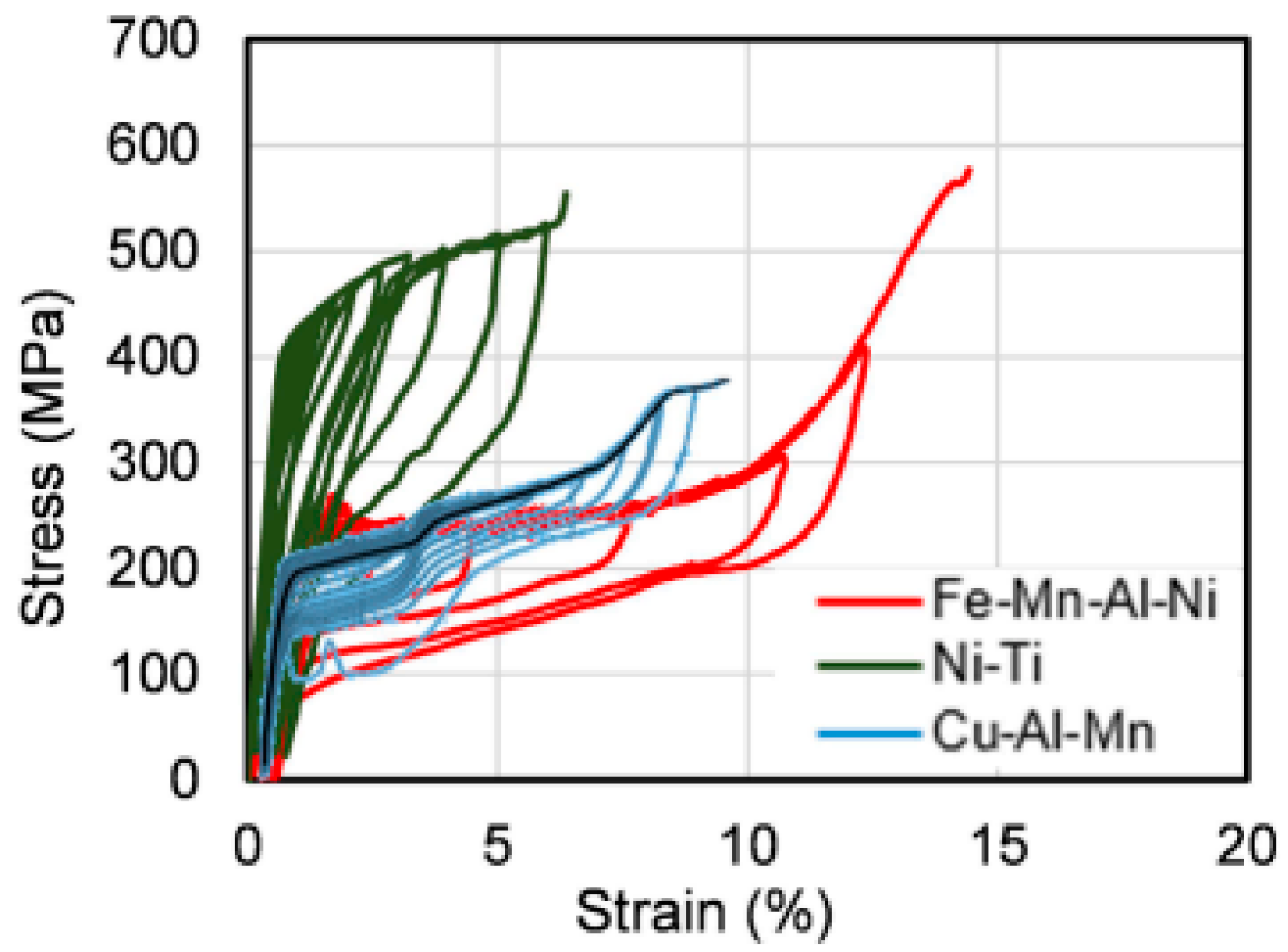
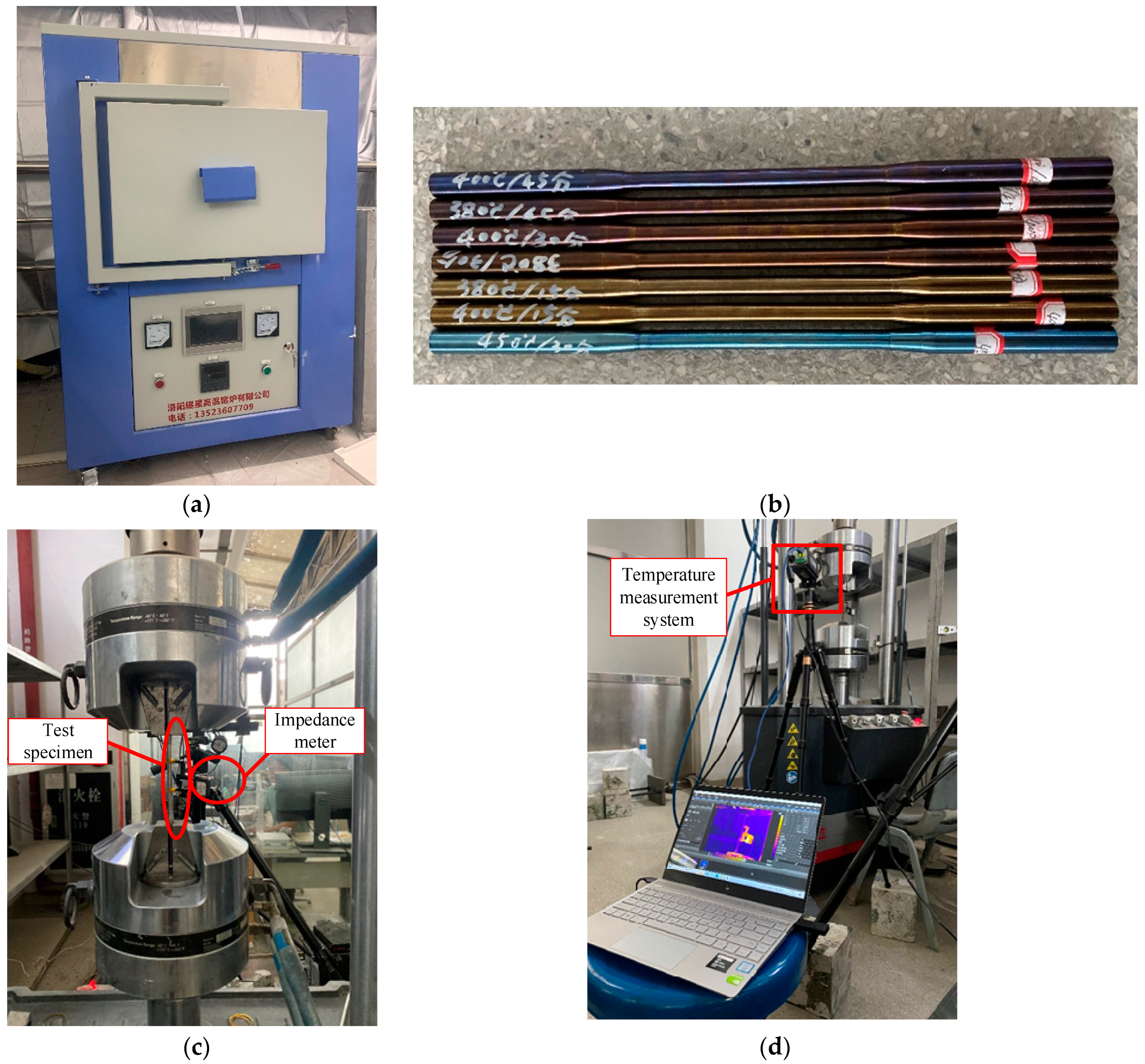
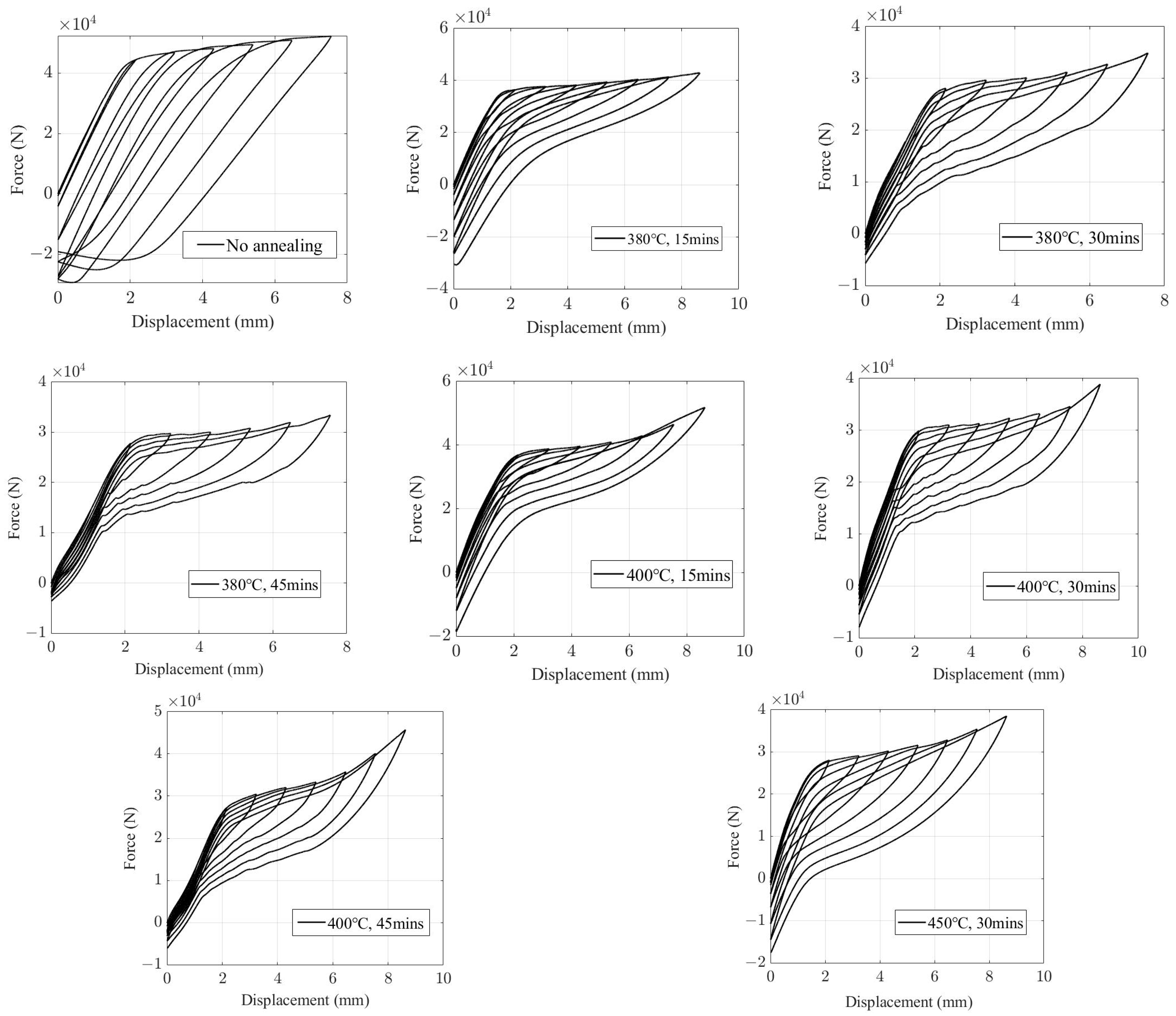
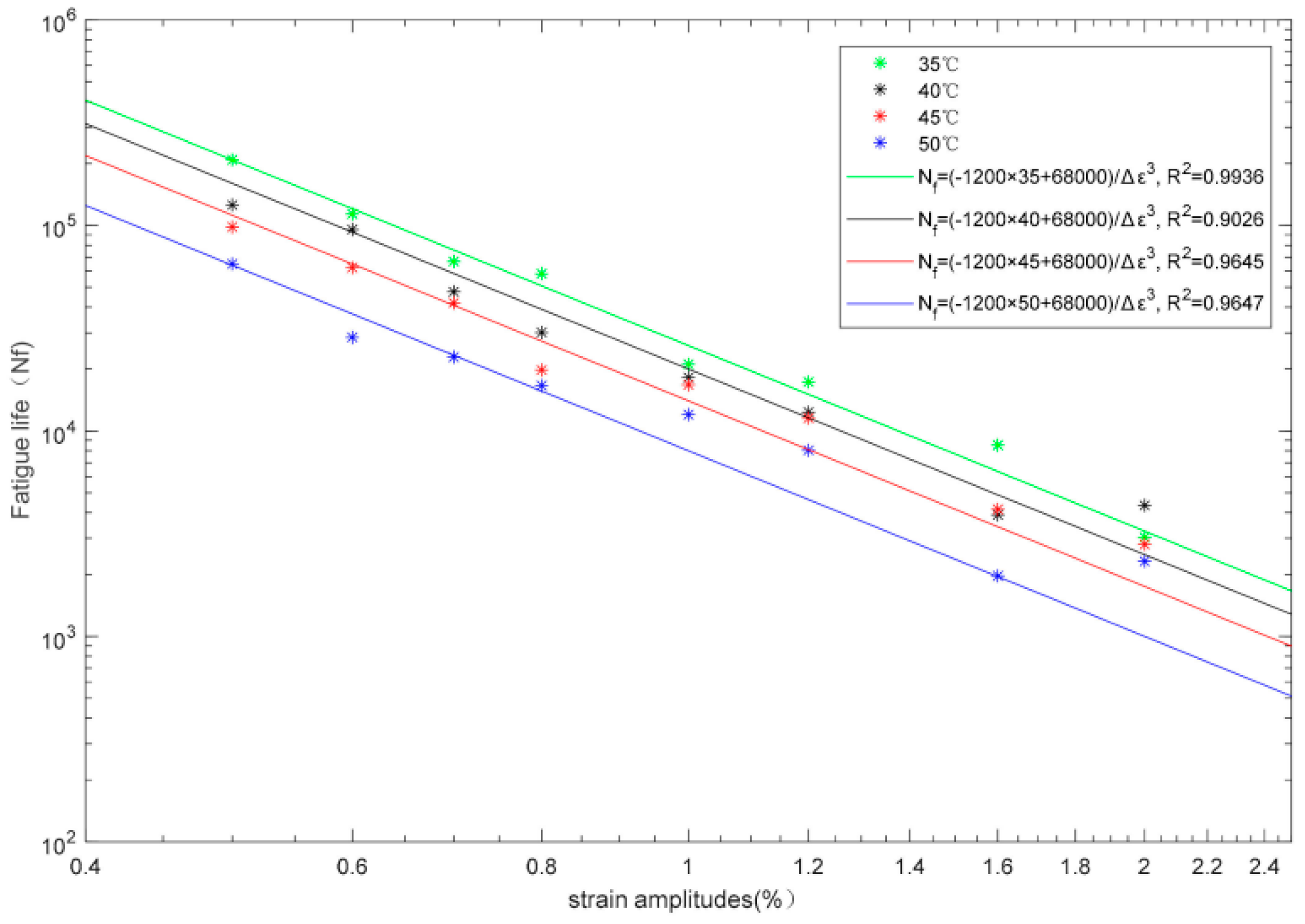
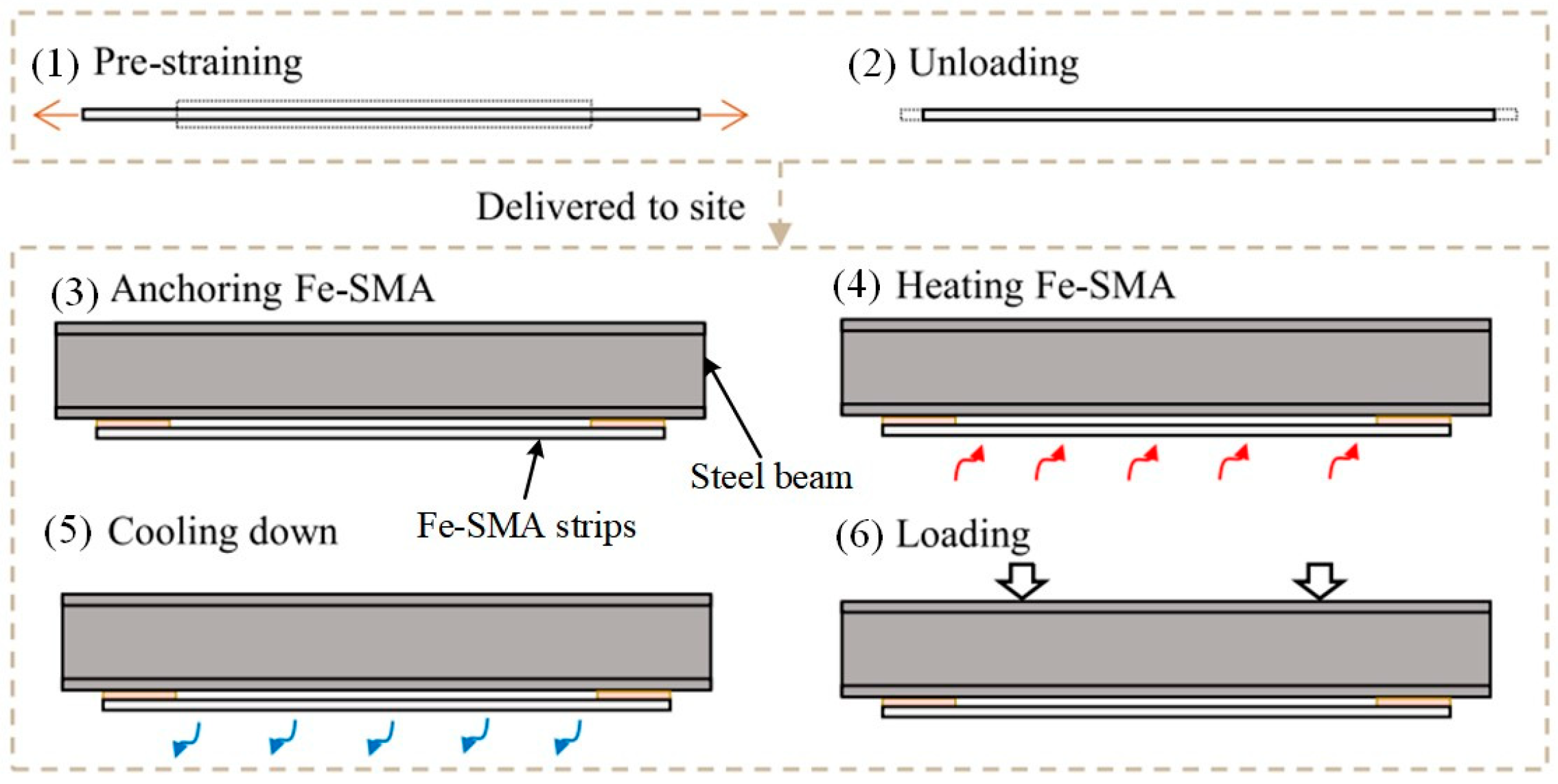







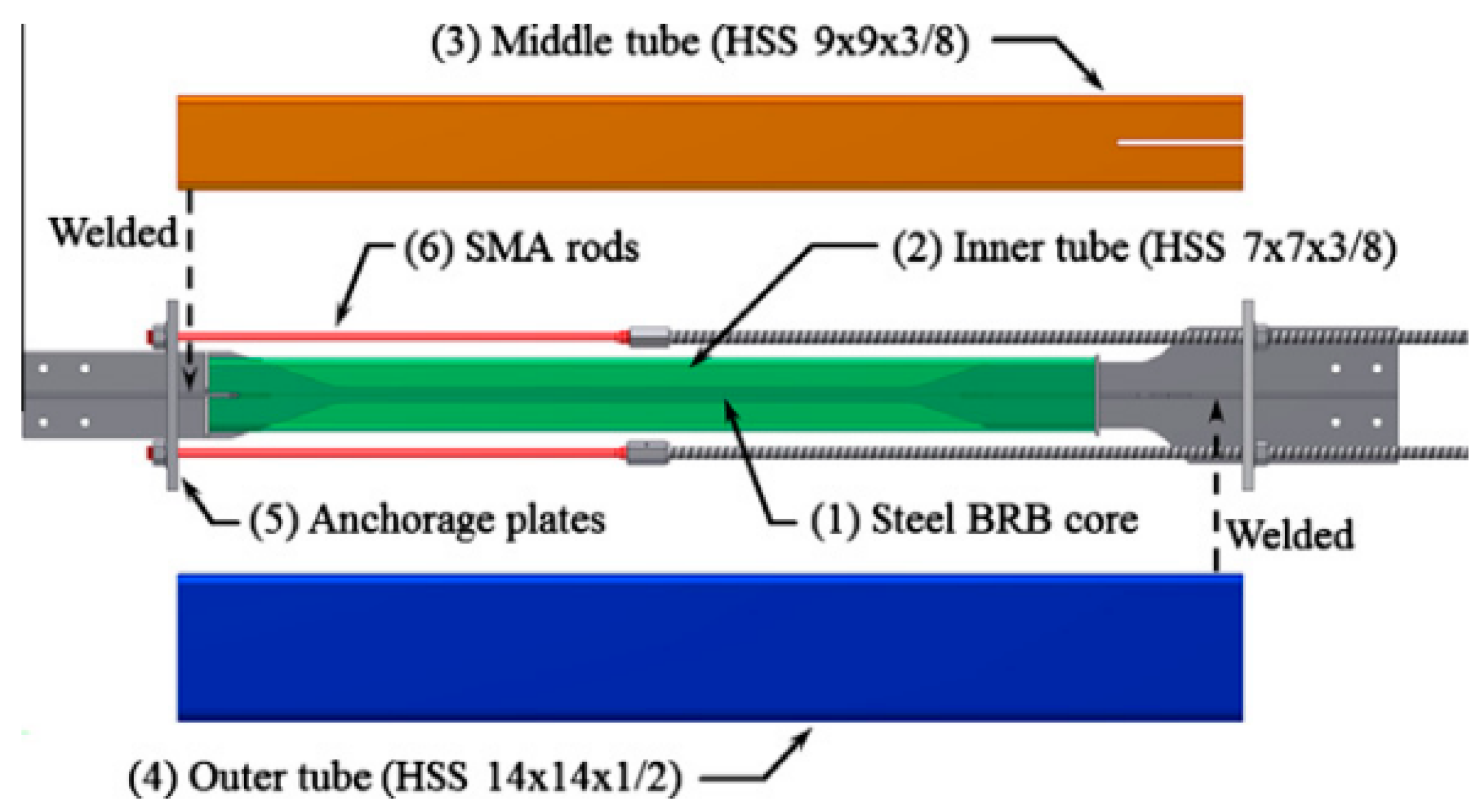
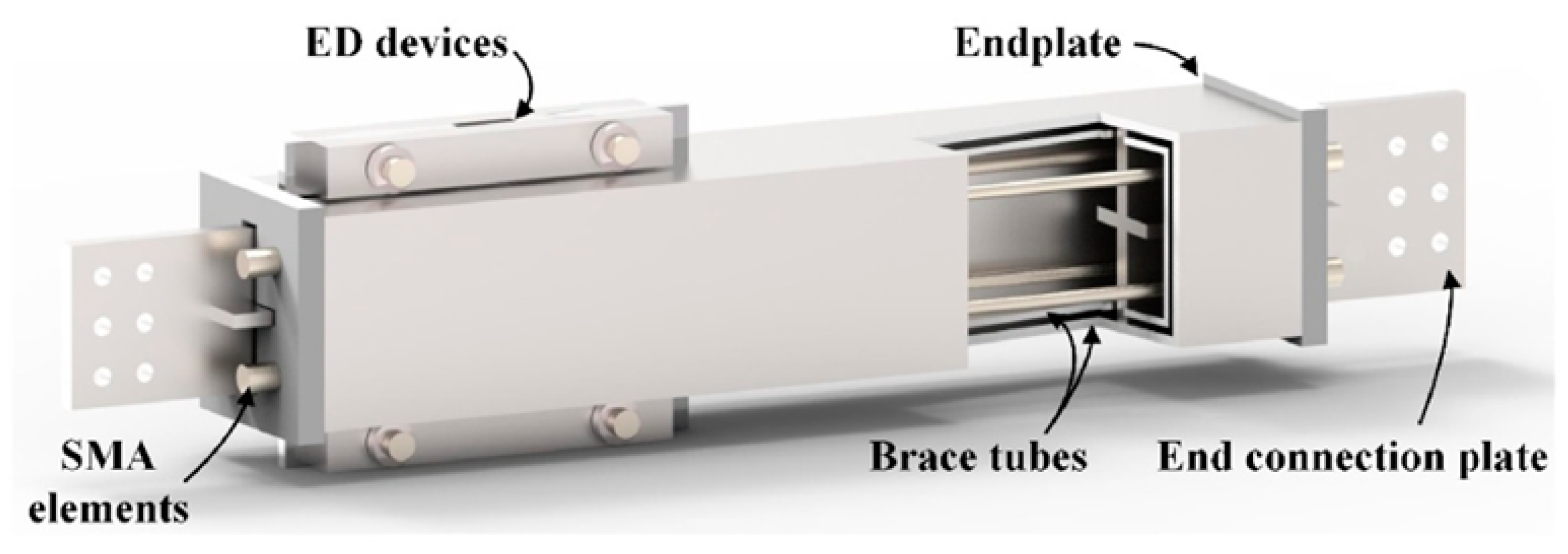


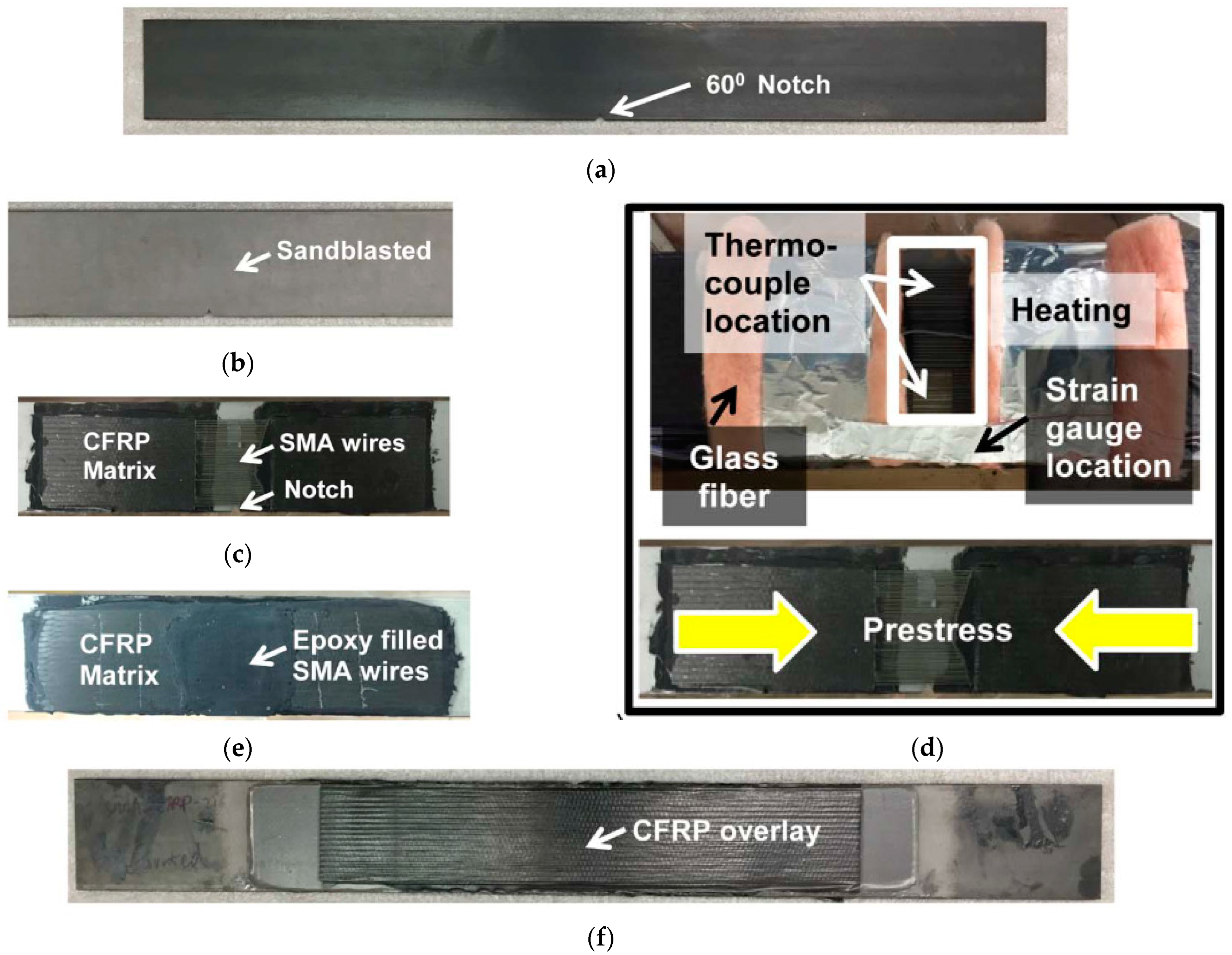
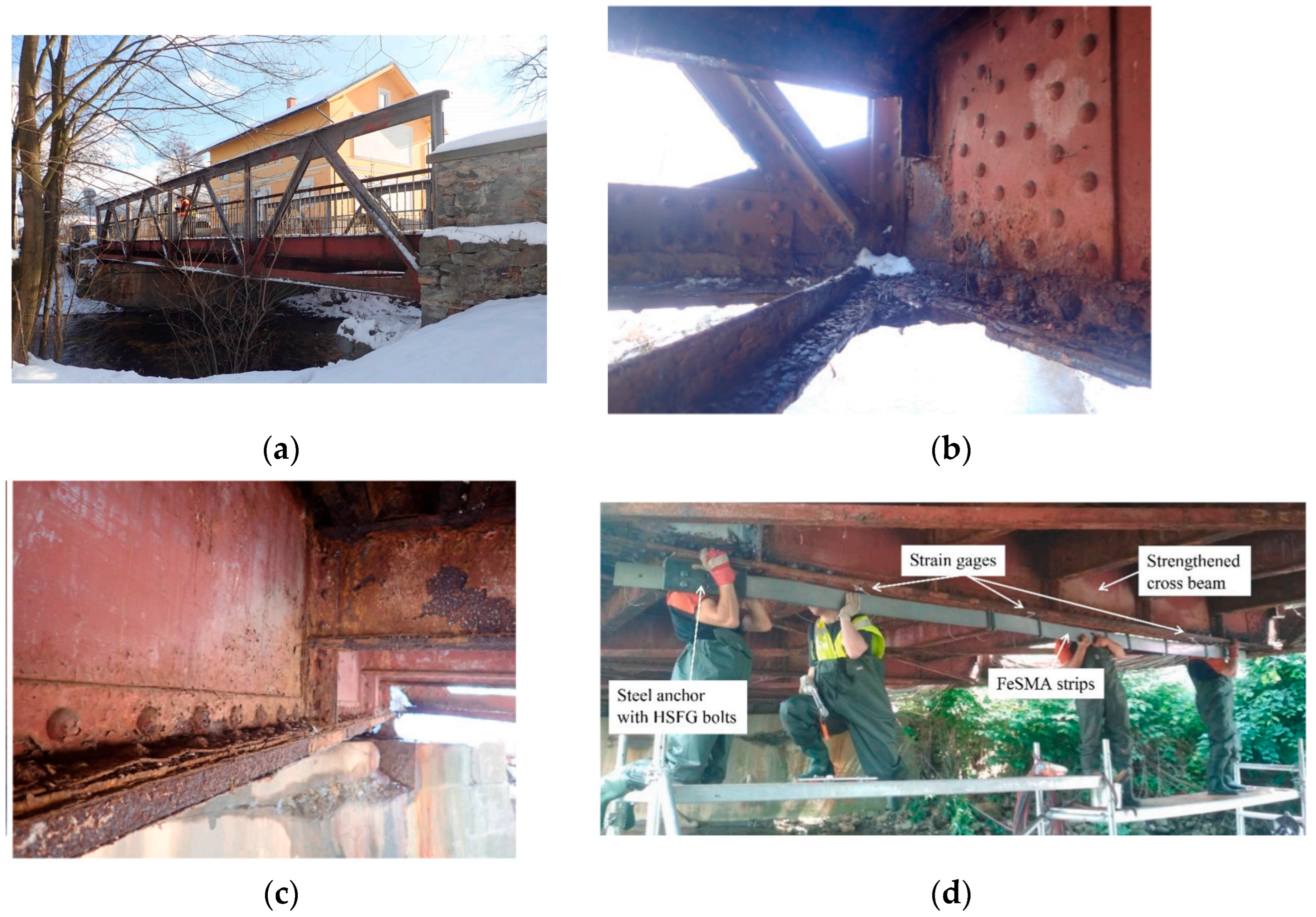
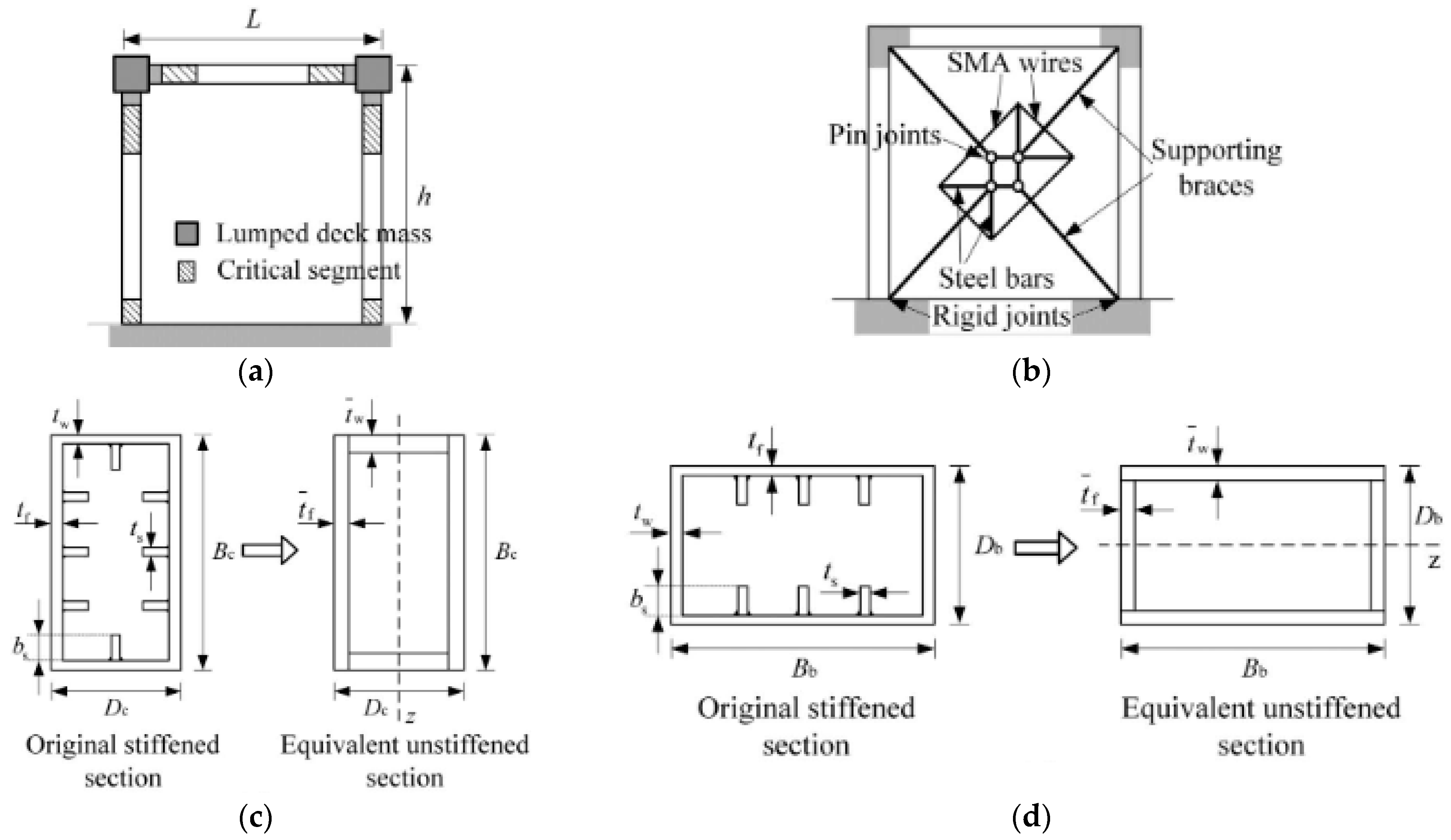
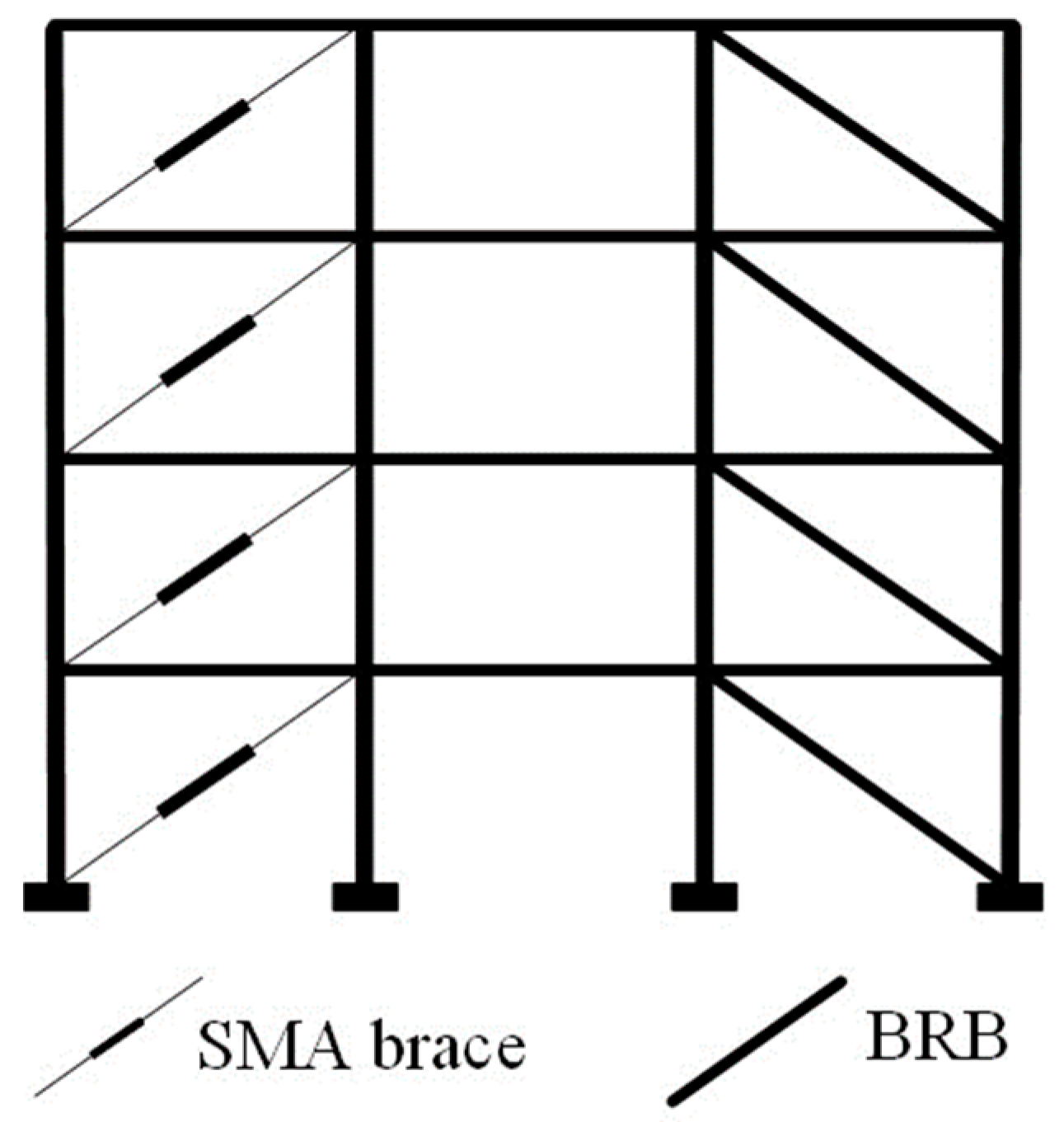
| Alloy | Elastic Modulus (GPa) | σMs (MPa) | Recovery Strain (%) | Af (°C) | Type | Reference |
|---|---|---|---|---|---|---|
| Ni50.02-Ti49.98 | 62.5 | 401 | 6 | −10 | Wire, cable, bar, plate, spring | [15,18] |
| Ni50.5-Ti49.5 | 45.3 | — | 4.6 | 53 | [19] | |
| Ni47.45-Ti37.86-Nb14.69 | 20 | 250 | 3.2 | 22 | [20] | |
| Cu71.9-Al16.6-Mn9.3 | 31.2 | 210 | 7 | −39 | Wire, cable, bar | [21] |
| Cu87.68-Al11.7-Be0.62 | 32 | 230 | 2.4 | −65 | [22] | |
| Fe17-Mn5-Si10-Cr4-Ni1-Vc63 | 165 | 396 | 3.5 | 162 | Bar, strip, plate | [23] |
| Alloy | Size (mm) | Pre-Strain (%) | Activation Temperature (°C) | Recovery Stress (MPa) | Reference |
|---|---|---|---|---|---|
| Fe-17Mn-5Si-10Cr-4Ni-1Vc | 0.7 × 3 | 4 | 225 | 380 | [47] |
| 4 | 160 | 330 | |||
| 0.9 × 3 | 4 | 160 | 580 | [48] | |
| 1.7 × 14 | 4 | 160 | 266 | [49] | |
| — | 4 | 160 | 350 | [50] | |
| 1.5 × 10 | 2 | 160 | 372 | [43] | |
| 1.7 × 25 | 2 | 160 | 177~200 | [51] | |
| 0.8 × 52.5 | 2 | 260 | 406 | [52] | |
| 1.5 × 100 | 2 | 160 | 292 | [53] | |
| 2 | 180 | 330 | |||
| Fe-28Mn-6Si-5Cr-0.53Nb-0.06C | — | 4 | 397 | [54] | |
| Fe-28Mn-6Si-5Cr | — | 3 | 300 | 255 | [55] |
| Fe-18Mn-8Cr-4Si-2Ni-0.36Nb-0.36N | 185 | ||||
| Fe-Mn-Si alloy | 1.5 × 20 | 2 | 160 | 308 | [56] |
| 4 | 160 | 348 | |||
| 1.5 × 15.8 | ≈3 | 155 | 268~295 | [57] |
Disclaimer/Publisher’s Note: The statements, opinions and data contained in all publications are solely those of the individual author(s) and contributor(s) and not of MDPI and/or the editor(s). MDPI and/or the editor(s) disclaim responsibility for any injury to people or property resulting from any ideas, methods, instructions or products referred to in the content. |
© 2023 by the authors. Licensee MDPI, Basel, Switzerland. This article is an open access article distributed under the terms and conditions of the Creative Commons Attribution (CC BY) license (https://creativecommons.org/licenses/by/4.0/).
Share and Cite
Shao, C.; Huang, Y. Advances in Shape Memory Alloy-Based Reinforcement in Steel Structures: A Review. Buildings 2023, 13, 2760. https://doi.org/10.3390/buildings13112760
Shao C, Huang Y. Advances in Shape Memory Alloy-Based Reinforcement in Steel Structures: A Review. Buildings. 2023; 13(11):2760. https://doi.org/10.3390/buildings13112760
Chicago/Turabian StyleShao, Chenxi, and Yonghui Huang. 2023. "Advances in Shape Memory Alloy-Based Reinforcement in Steel Structures: A Review" Buildings 13, no. 11: 2760. https://doi.org/10.3390/buildings13112760
APA StyleShao, C., & Huang, Y. (2023). Advances in Shape Memory Alloy-Based Reinforcement in Steel Structures: A Review. Buildings, 13(11), 2760. https://doi.org/10.3390/buildings13112760







